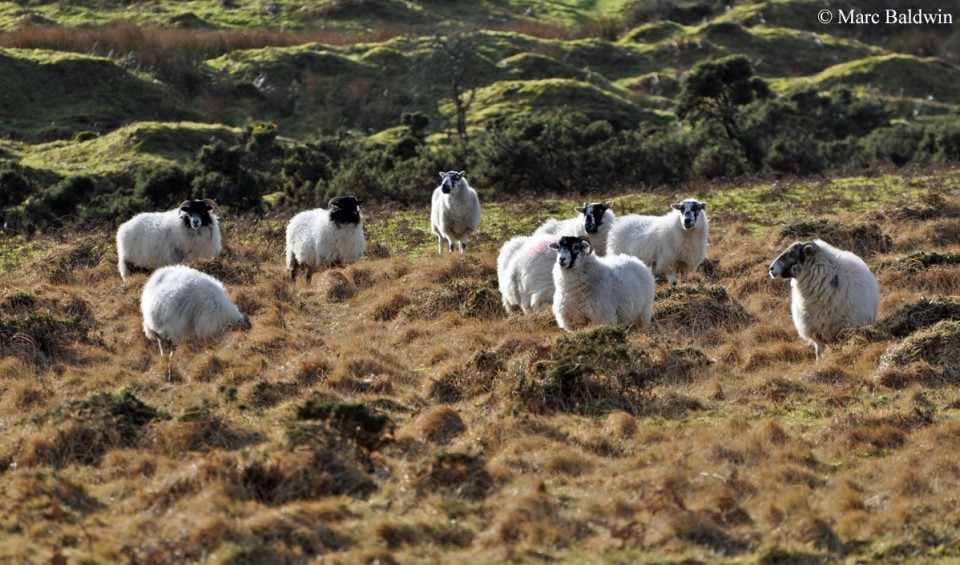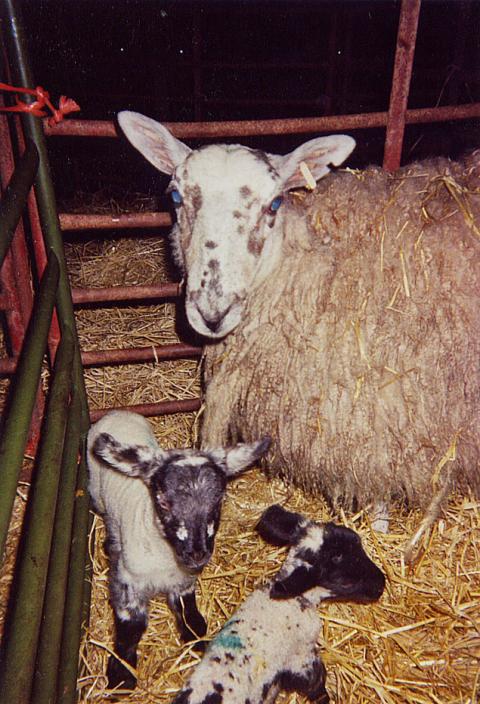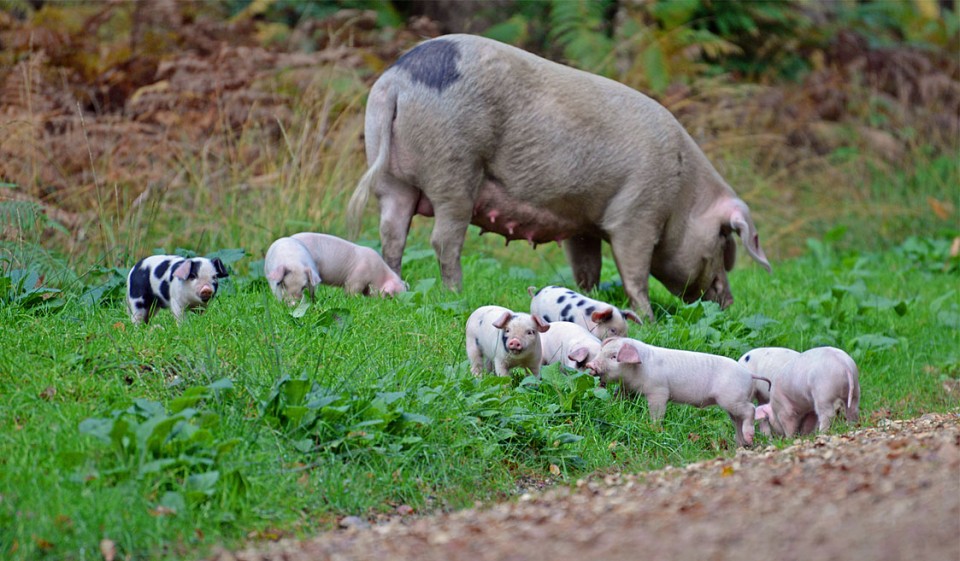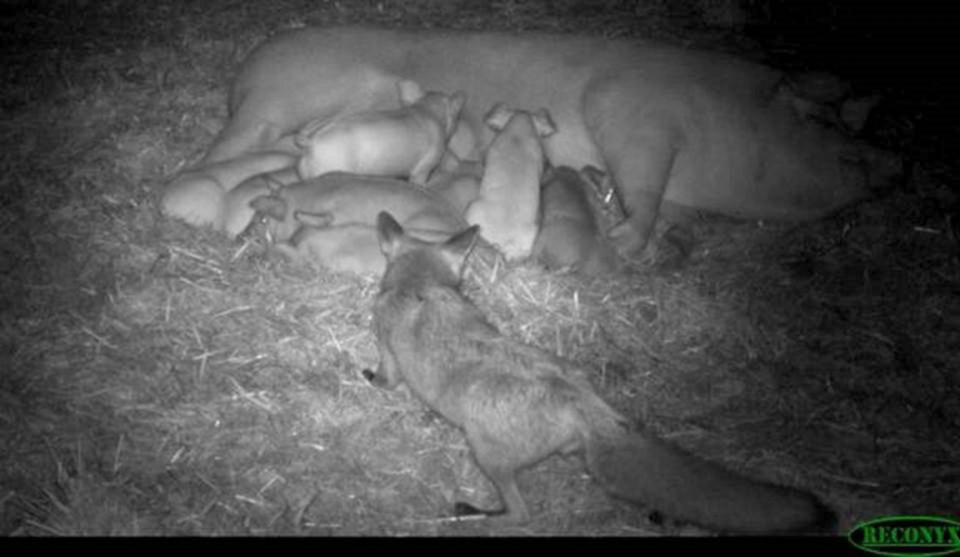Red Fox Interaction with Other Species - Livestock
It is their attacks on man’s livestock that has probably contributed more to the fox’s status as a pest than any other interaction. Foxes are well known to take lambs, young goats, chickens, geese, and piglets if the opportunity arises – there are also sporadic reports of foxes trying their luck with mature sheep, calves, pony foals and even full-grown cows. Indeed, in his book Town Fox, Country Fox, Brian Vezey-Fitzgerald talked about a remarkable crop of sensational stories that made the press during the very harsh winter of 1963; one, in the Farnham Herald, told how a pack of foxes chased a four-foot-tall bullock before it was cornered in a ditch and “torn to pieces”.
Vezey-Fitzgerald noted, however, that this scene was reconstructed from footprints in the snow, rather than first-hand testimony. Thus, he considered what actually happened was the bullock missed its footing and fell into a ditch, whereupon it died of hypothermia and the carcass was visited by foxes. Whatever really happened (and Occam’s Razor would point to Vezey-Fitzgerald’s argument), it illustrates an interesting point: that foxes are seldom actually seen taking livestock. Instead they are often assumed to have been the culprit. This makes accurate assessment very difficult. As such, while there can be no argument that, at a local scale, foxes have the potential to cause significant losses, how significant they are to the national livestock industry is a highly contentious issue.
Sheep and lambs
In his 1940 classic, I Bought A Mountain, Thomas Firbank wrote that a considerable number of lambs are killed by foxes in the hilly grazing land around Snowdonia each year and, writing in his 1947 book Farmers’ Warfare, Charles Walton considered mountain sheep farmers suffered “very considerable losses from fox depredations, and, at times, foxes can certainly cause a ghastly slaughter of lambs”. (In Walton’s opinion, such trouble is more likely if rabbits are scarce.)

Published data on lamb losses is rather sparse. In his 1984 contribution to the Journal of Applied Ecology, Ray Hewson at Aberdeen University studied the diets of foxes in two areas of western Scotland. Hewson found that foxes in these areas fed primarily on sheep carrion and field voles, supplementing their diet by killing about 1.3% of the lambs estimated to have been born in the area during 1976. Hewson provided minimum values for lambs killed of 1.8%, 0.8% and 0.6% of the lambs estimated to have been born in 1977, 1978 and 1979, respectively. The paper reported that foxes and eagles killed lambs of one to five days old and in apparently good condition; foxes took lambs up to 10 kg (22 lbs) in weight, while eagles only took lambs as heavy as 6 kg (13 lbs).
Hewson observed several other trends -- such as foxes consuming more carrion in the first half of the year and more field voles in the second -- and speculated that, with regards to lamb susceptibility to foxes, lambs of ewes breeding for the first time (compared to those of older ewes) may have been more vulnerable owing to poorer maternal care instincts.
A similar study in Wales found that sheep carrion was an important food source for the foxes during the summer, found in about 40% of stomachs, but evidence for direct predation was lacking. In New South Wales, Robyn Molsher and her colleagues at CSIRO found sheep remains in 78 (31%) of the 255 fox stomachs collected from around Lake Burrendong and suggested that most probably represented carrion, but also noted that seasonal peaks in sheep remains found during the spring may also reflect predation on newborn lambs.
In his book, Running with the Fox, David Macdonald is of the opinion that foxes only rarely take lambs and, while tracking foxes in the lambing fields of the Cumbrian Fells, he found that they appeared disinterested in the lambs, sprinting after rabbits in the same fields. The foxes did, however, consume afterbirth and appeared to eat the lambs’ dung, presumably because the milky faeces of young lambs are rich in undigested fats and proteins. In the territories of two vixens on Orton Scar, Macdonald found a total of four lamb carcasses that had been partially eaten by foxes; two showed no sign of bleeding and were presumably dead before the fox took them. Macdonald readily accepts that he may have missed some corpses, but found no evidence for any substantial consumption of lambs that year:
“Considering the number of foxes in most areas, if most of them killed lambs habitually the losses would be astronomical. Since they are not, I presume that most foxes rarely or never kill a lamb.”

Macdonald suggested that, as lamb/sheep carcasses are left out to rot (often visited and defecated on by foxes, but rarely eaten) and the vixens he watched were dodging lambs in the pursuit of rabbits as though “the lambs were obstacles rather than food”, lamb is probably not a preferred food for most foxes. The geographical difference in lamb predation rates, Macdonald considered, probably reflects the availability of other, more desirable, prey. Indeed, Macdonald’s captive studies in Oxford seem to provide some support for this theory; his foxes refused to eat the lambs he presented to them unless nothing else was available. This doesn’t, however, explain why foxes appear to relish the after-birth, withered tails and testes that drop off ‘branded’ lambs. Of course, these observations represent one population in a single year, but they certainly imply that not all foxes are lamb-killers – a conclusion that many farmers and gamekeepers have also come to.
During a series of detailed observations of foxes among lambing ewes in Australia, for example, both G. Alexander and colleagues (writing in 1964) and Peter Mawson with the late John Long (in 1989) described how foxes were generally wary of newborn lambs, but that at least one individual was observed to attack and kill a healthy lamb. In addition, subsequent work by Australian biologist Ian Lugton (see below) suggests that mature male foxes are more likely to prey on lambs than either vixens or juveniles. This implies that there may be certain “problem foxes” more prone to lamb predation. Indeed, such “rogues” are frequently reported by landowners, who describe animals that appear to learn how to tackle chickens and lambs; when these animals are removed the losses stop, even though there are other foxes in the area.
In Australia, Carolyn Greentree and colleagues at the Vertebrate Pest Research Unit in New South Wales found that fox predation was the probable cause of death for a minimum of 0.8% and a maximum of 5.3% of the 1,321 lamb carcasses they examined. In their paper to the Journal of Applied Ecology, the biologists report that fox control three times per year reduced the maximum percentage of lamb carcasses attributed to foxes from 10% to just less than 4%. Other studies in Australia have produced similar figures: foxes killed 3-4% of the healthy lambs and, in one study, a substantially higher proportion (17%) of sick/starving ones. Indeed, lambing indoors significantly improves survival of the offspring by not only removing the threat from predators, but also providing immediate assistance from a farmer in the case of trouble.
Also in Australia, Lugton studied the diets of 212 foxes from south-west New South Wales between 1985 and 1989 – he found sheep remains in 31% of cases, with fresh newborn (i.e. up to a month old) lambs identified in just fewer than 4% of all stomachs on average. This average, as is often the case, masks regional variation and Lugton noted that evidence of lamb consumption was ten-times greater (i.e. 35%) among foxes collected within a kilometre of lambing flocks. Lugton concluded that where fox density was high, with a high proportion of older animals in the population, and alternative preferred food (particularly house mice) was scarce, lamb predation was likely to be severe. Subsequent to this, Lugton autopsied 172 lambs, most less than three days old, between April 1985 and the spring of 1992 and found that, of the 131 for which a cause of death could be assigned, 40 (23%) were considered to have been killed by foxes. Of these lambs, 15 (11%) were in apparently good condition -- i.e. had primary fat reserves intact -- while the others were either very thin or too damaged to be able to tell. The bulk (58%) of dead lambs died because they failed to suckle.
More recently, Rebecca Moberly and four of her colleagues at Bristol University surveyed sheep farmers across the UK about the levels of fox predation on lambs. The results of their questionnaire -- published in the journal Wildlife Research in 2003 -- showed that, although individual losses were low, the range of "perceived losses” to foxes was high: 0.0008 to 0.26 lambs per ewe (i.e. 1 lamb lost per 1,250 ewes to 1 per 4 ewes). The paper also reports that fox predation was more likely to have occurred on larger farms and that 59% of those who responded to the survey had reputedly lost at least one lamb at their most recent lambing. As in Australia, the researchers found that indoor lambing was an important preventative measure against fox predation.

As observed by Greentree and her co-workers, the timing of any fox control can also have a sizable impact on lamb survival. A huge study of fox control in Australia, for example, found that fox predation on lambs was significantly reduced if culling was carried out twice per year -- during the autumn and again in late winter or early spring -- and farms operating a “good neighbour policy” (i.e. each controlling foxes on their land) had fewer lamb losses than those that didn’t. In 2011, one Cornish farmer I spoke to told me that he started culling foxes on his land when he lost a lamb – he explained that it was essentially the same as taking £100 (120 EUR or 160 USD) out of his wallet and setting fire to it.
Obviously, this cost has to be weighed against the costs of fox control, but as most farmers will cull foxes themselves it generally has little perceived direct cost, and many farmers consider it worthwhile. Some farmers may also view fox control as something tangible they can do to protect their lambs, when factors such as failing to suckle, stillbirth and birth defects are out of their hands. Moreover, there are often statements made about how many more lambs die from lapses in husbandry or maternal care than fall prey to foxes. While this is true, it implies farmers ignore the obvious and target foxes, which has not been my experience. Instead farmers try and tackle as many issues as possible, major and trivial. After all, know turning the light off when leaving the room saves relatively little money compared to closing the front door when the heating’s on; but we still turn the light off.
How much these losses cost the sheep industry as a whole remains something of an unknown. A study of blackface lamb production in the Scottish Hills between 1993 and 1996 estimated that foxes took 1.5% of the total potential revenue on one farm and 0.6% on another – this equated to, depending on the year, £75 to £300 (90-361 EUR or 118-474 USD) for the first farm and £34 to £134 (41-161 EUR or 54-212 USD) on the second. I know of no similar figures for English or Welsh lamb production.
Poultry
Many poultry losses occur on residential holdings (i.e. people who keep chickens in their back garden or on their allotment) and, as such, there are no figures for the numbers killed or the estimated cost. There are some cases, however, where chickens are taken from farms. A survey by the GCWT found that, among farmers with free-ranging poultry, half to almost 80% of respondents reported losses in the year leading up to being questioned. The occurrence roughly mirrored estimated fox abundance; the fewest cases in west Norfolk, while the east Midlands had the most. The GWCT also found that the presence of a gamekeeper significantly reduced the likelihood that poultry would be lost, although recommended that secure fencing/housing should also be employed where practicable. Indeed, in their 2004 study on fox predation of free-ranging poultry flocks in Britain, published in Veterinary Record, Rebecca Moberley and her colleagues at Bristol University noted how:
"… changes in farm management would be the most cost-effective means of reducing fox predation, rather than greater fox control"

It seems that, of the farmers surveyed, egg producers reported losing the most birds; up to 77.6% in one case. Overall, however, the average reported mortality across the sample was less than 2%, but with significant local/individual variation. It is worth remembering that averages tend to “smooth out” the perceived risk for any individual stakeholder. If, for example, there are 10 farms in an area and a total of 10 birds are taken in that area over the year, the average is a single chicken per farm while in reality all 10 could’ve been lost from a single farm and the other nine didn’t suffer any losses. This just reinforces the need to be careful when using such statistics.
Piglets
There are many reports of foxes carrying away piglets from farms and, in their 1994 analysis of the mortality of piglets reared outdoors published in Veterinary Record, Sandra Edwards and her colleagues noted:
“The predation of piglets by foxes has long been recognised as a problem at some outdoor units …”
Unfortunately, there are comparatively few data on this and it is not clear how many accounts of foxes removing piglets represents predation and how many were scavenged when already dead. The only UK-based study I’m aware of was conducted by D.F. Richards in Devon during the early 1970s. Richards found piglet remains in 4% of fox scats that he examined but, upon liaison with local farmers, all cases were tracked back to dead animals buried in an orchard and subsequently exhumed by the foxes. In his 1977 paper to the Journal of Zoology, Richards explained:
“No live piglets could be proved to have been taken by foxes, although on one occasion a fox was seen in a farrowing house.”

Obviously, “could not be proved” does not mean predation never happened, but the paucity of data makes it difficult to quantify. In addition, during their study of foxes living in the vicinity of Lake Burrendong in New South Wales, Robyn Molsher and her team found pig remains in only one of the 255 stomachs they analysed, which they considered to have been scavenged carrion.
A more recent study, published in the journal Mammal Research during 2015, looked at the change in the diet of foxes in Denmark between 1974 and the present day in association with changes in agricultural practices in the region. The dataset shows a decline in the incidence of both piglets and domestic poultry in the diet in recent years and the authors suggest that this is associated with a change to the way Danish farmers deal with dead livestock:
"The reduced occurrence of domestic pigs and poultry is due to changed husbandry and stricter regulation on carcase [sic] disposal. In 1974, it was still common to discard dead pigs and hens on the dunghills behind the farm. Today, it is mandatory to leave dead piglets and poultry in closed containers to be collected for rendering by a special collection service."
The most recent and comprehensive study of which I’m aware was conducted by team at Murdoch University in Australia led by Patricia Fleming and published in the journal Animals in 2016. The study was conducted at a commercial piggery in western Australia, home to 3,500 sows that weaned an average of 1,000 piglets per week. Nineteen remote cameras were deployed in the farrowing paddocks between August and December 2014 to monitor the piglets.

The cameras revealed that the “carcass pit”, where dead piglets were placed by staff, was a significant draw for foxes – up to 14 visits per night were made to the pit, with five foxes captured in on photograph. Foxes were seen returning from the carcass pit carrying scavenged piglet carcasses on numerous occasions. More importantly for the piggery owner, foxes were observed entering the farrowing huts and several cases of foxes taking live piglets, even while they were suckling from the sow, were recorded. Overall, foxes could be positively assigned to eight piglet deaths (0.13%) during the study, but the authors suggest they were also probably responsible for many of the 20% of piglets reported as “missing” during the first week after birth. In their paper, Flemming and her team conclude:
“We suggest that the impact of fox predation in outdoor piggeries has been significantly underestimated, because foxes take some newborn piglets born overnight before they are even recorded by piggery staff. At present, confirmed fox predation is only recorded for carcasses that are obviously “chewed” upon, but piglet carcasses monitored by camera or through GPS trackers revealed that foxes removed the carcasses from paddocks to eat them (possibly under cover). Therefore, far fewer losses are attributed to foxes than are likely to be occurring.”
Indeed, of the 32 piglet carcasses the researchers fitted with GPS trackers, 12 were removed by foxes and taken, on average, 170 metres (558 ft.) from the piggery – some were taken only 2m (6.5 ft.), others as far as 724m (almost half a mile). Importantly, a cull of nine foxes by the farm manager in December 2014 had no noticeable impact on the rate foxes were caught on the cameras, illustrating how difficult it can be to control fox numbers by local shooting alone. Perhaps the most interesting finding from this study was that even if foxes were assumed responsible for all the missing piglets, they account for about one-fifth of piglet deaths. More than three-quarters (75.6%) of deaths resulted from “lay-overs”, where the sow rolls over and crushes a piglet. Nonetheless, Fleming and her colleagues estimated that a 20% loss of piglets to foxes equated to a loss of income of $20,000 per week.
Goats
A study looking at fox predation on goats was conducted in western Australia by John Long and colleagues at the Agriculture Protection Board during the 1980s. Long and his co-workers report, in their 1988 paper to the Journal of Agriculture Western Australia, that foxes were assumed to have killed 16 (6%) of the 257 Cashmere goat kids in their study population. Kids younger than three-months were most at risk, and were killed by bites to the abdomen and pelvic region.

Molsher and her colleagues found goat remains in the stomachs of four foxes and, in their 2000 paper to the journal Wildlife Research, note:
“Other carrion (cattle, pigs and goats) was of minor importance, except in June 1996, when goats dominated the diet of four foxes. These foxes were collected from near a paddock where farmed feral goats were kidding.”